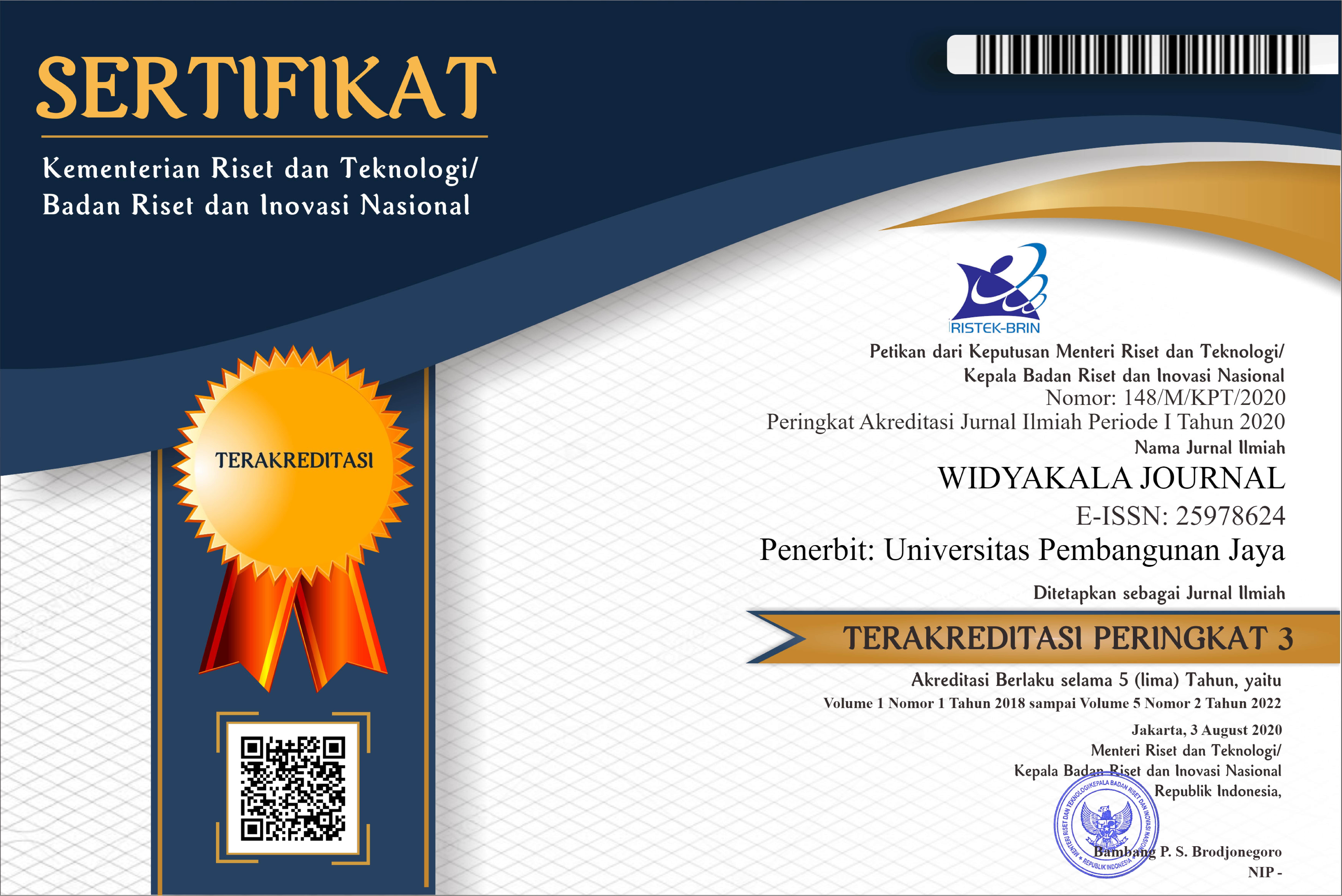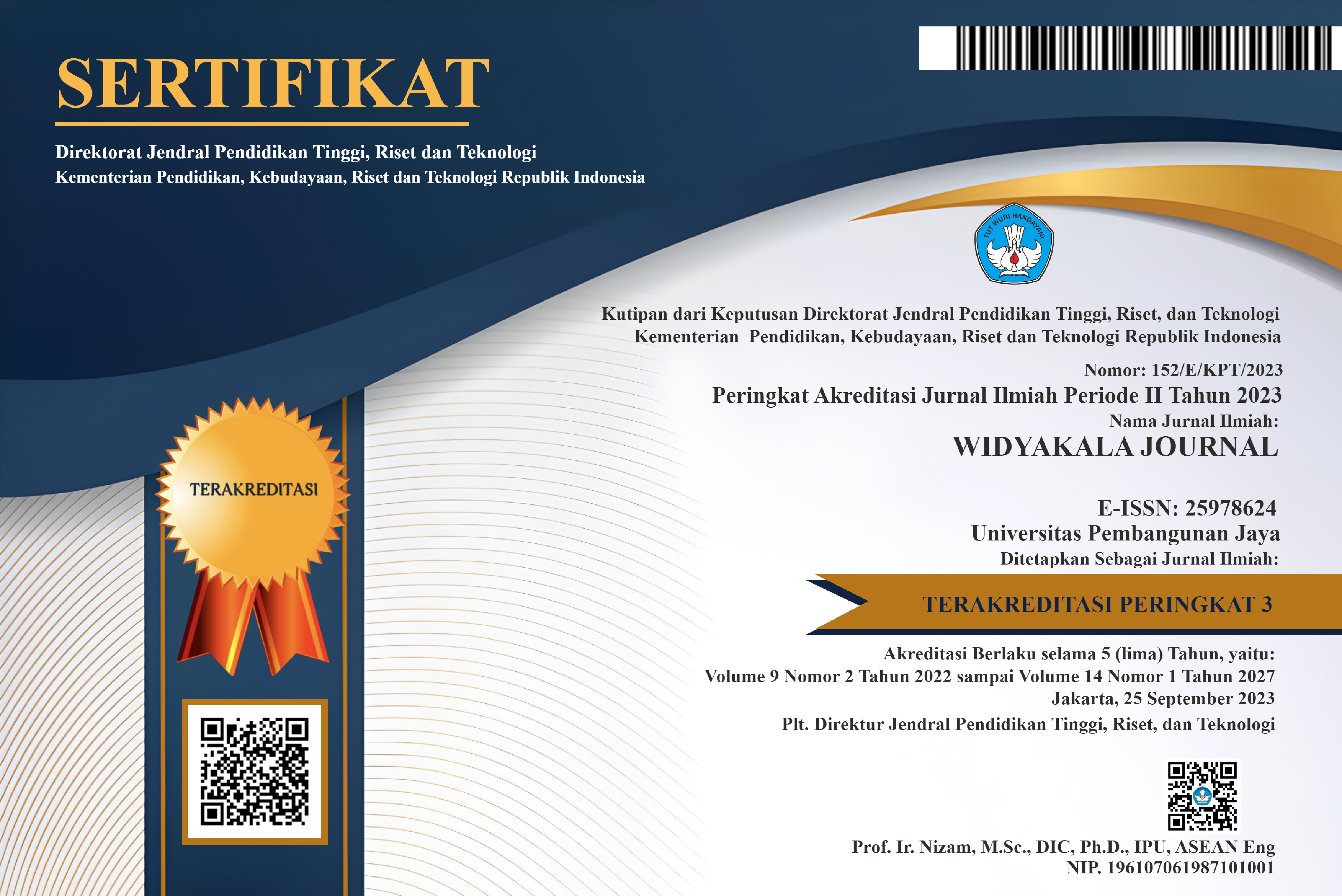Updated, March 2025
Determinants of QRIS Payment Method Usage for Employees in Urban Areas
Abstract
Keywords
Full Text:
PDFReferences
Abebe, F., & Lessa, L. (2020). Factors Affecting Mobile Payment Adoption by Merchants in Ethiopia. The 6th African Conference on Information Systems and Technology (ACIST2020), 1–11.
Afriani, A. L., & Sujono, F. K. (2019). The Use of Mobile Wallet Services Apps in Urban Living BT - Proceedings of the 2nd International Conference on Strategic and Global Studies (ICSGS 2018). 99–103. https://doi.org/10.2991/icsgs-18.2019.14
Agung, H., Christian, M., & Loisa, J. (2020). Perilaku Pengguna Shopee Terhadap Pembelian Multiproduk dengan Pendekatan Theory of Reasoned Action. Go-Integratif : Jurnal Teknik Sistem Dan Industri, 01(01), 11–23. https://doi.org/10.35261/gijtsi.v1i01.4005
Akcin, M., Kaygusuz, A., Karabiber, A., Alagoz, S., Alagoz, B. B., & Keles, C. (2016). Opportunities for energy efficiency in smart cities. 2016 4th International Istanbul Smart Grid Congress and Fair (ICSG), 1–5. https://doi.org/10.1109/SGCF.2016.7492425
Al-Saedi, K., Al-Emran, M., Ramayah, T., & Abusham, E. (2020). Developing a general extended UTAUT model for M-payment adoption. Technology in Society, 62, 101293. https://doi.org/https://doi.org/10.1016/j.techsoc.2020.101293
Aliyu, A. A., Younus, S. M. ., & Tasmin, R. B. H. (20212). An Exploratory Study on Adoption of Electronic Banking: Underlying Consumer Behaviour and Critical Success Factors. Case of Nigeria. Business and Management Review, 2(1), 1–6.
Alqudah, H., Al Natour, A. R., Al-Kofahi, M., Rahman, M. S. A., Abutaber, T. A., & Al-Okaily, M. (2022). Determinants of the Cashless Payment Systems Acceptance in Developing Countries: Evidence from Jordanian Public Sector Employees BT - Artificial Intelligence for Sustainable Finance and Sustainable Technology. In A. M. A. Musleh Al-Sartawi (Ed.), The International Conference On Global Economic Revolutions (pp. 593–601). Springer International Publishing. https://doi.org/10.1007/978-3-030-93464-4_58
Auliya, S. N., Rahman, A., & Purwanto, D. (2022). Fenomena Perilaku Konsumsi menggunakan Sistem Pembayaran Cashless (Studi Kasus Masyarakat di Kabupaten Kendal). Sosio E-Kons, 14(1), 88–98. https://doi.org/10.30998/sosioekons.v14i1.11924
Bakhitah, A., Indra, R., Halim, W., Ferbian, V., & Hidayat, Z. (2023). QRIS as a Drivers of Product Distribution Flows in Indonesia: Factors of Consumer Purchasing Behavior in the Use of Fintech Payments. Journal of Distribution Science, 21(12), 59–69. https://doi.org/10.15722/jds.21.12.202312.59
Banerjee, S., & Saha, P. (2021). Study of Consumer Behaviour Towards Digital Payment: An Empirical Study With Reference to Kolkata. International Journal of Engineering Applied Sciences and Technology, 6(1), 159–167. https://doi.org/10.33564/IJEAST.2021.v06i01.022
Cebeci, U., Ertug, A., & Turkcan, H. (2020). Exploring the determinants of intention to use self-checkout systems in super market chain and its application. Management Science Letters, 10(5), 1027–1036. https://doi.org/10.5267/j.msl.2019.11.007
Chang, H. H. (2006). Technical and management perceptions of enterprise information system importance, implementation and benefits. Information Systems Journal, 16(3), 263–292. https://doi.org/https://doi.org/10.1111/j.1365-2575.2006.00217.x
Christian, M., Gularso, K., Samodra, G. S., Yuniarto, Y., Wibowo, S., Sunarno, S., & Syafani, F. (2023). The Mediating and Moderating Role of Work-life Balance on Performance of Distribution Center Employees. Journal of Distribution Science, 21(11), 55–66. https://doi.org/10.15722/jds.21.11.202311.55
Christian, M., Gularso, K., Utomo, P., Yulita, H., Wibowo, S., Sunarno, S., & Melati, R. (2023). Generation YZ’s E-Healthcare Use Factors Distribution in COVID-19’s Third Year: A UTAUT Modeling. Journal of Distribution Science, 21(7), 117–129. https://doi.org/10.15722/jds.21.07.202307.117
Christian, M., Yulita, H., Girsang, L. R., Wibowo, S., Indriyarti, E. R., & Sunarno, S. (2023). The Impact of Cashless Payment in Application-Based Transportation on Gen Z User Behavior in Jakarta. 2023 International Conference on IT Innovation and Knowledge Discovery (ITIKD), 1–6. https://doi.org/10.1109/ITIKD56332.2023.10100198
Christian, M., Yulita, H., Sander, O. A., Sunarno, S., Leonardo, M. C., & Arifin, P. (2024). The Use of Quick Response Code Indonesian Standard (QRIS) in Jakarta: Are Usefulness and Resistance to Technology Stronger Than Perceived Security and Technological Anxiety? BT - Technology: Toward Business Sustainability (B. Alareeni & A. Hamdan (eds.); pp. 258–266). Springer Nature Switzerland.
Destianingsi, D., Nuredi, R., Hidayat, E., & Faizal, L. (2023). Analisis Perlindungan Hukum Bagi Konsumen Pada Transaksi Pembayaran Nontunai Berbasis QRIS (Quick Response Code Indonesian Standard) Perspektif Hukum Positif dan Hukum Ekonomi Syariah. Jurnal Ilmiah Edunomika, 7(12), 1–13. https://doi.org/10.29040/jie.v7i2.9780
Dhanalakshmi, S., Komalavalli, K., & Hemalatha, R. (2019). The Cashless Economy and its Effects Among the Salaried Employees in Chennai City. International Journal of Recent Technology and Engineering (IJRTE), 8(4S3), 113–116. https://doi.org/10.35940/ijrte.D1012.1284S319
Ediputra, M. R., & Amalyah, A. A. (2022). Analysis Factors Affecting Consumer Preferences in using Qris Payment In-Store. 2022 5th International Conference of Computer and Informatics Engineering (IC2IE), 29–34. https://doi.org/10.1109/IC2IE56416.2022.9970086
Elango, D., & Pimpin, S. (2020). Consumer’s Intention to use a Cashless payment application in Thailand. Journal of Research and Multidisciplinary, 3(2), 313–325. https://doi.org/10.5281/jrm.v3i2.37
Erwinsyah, E., Ningsih, K. E., S, S., & Anjelita, K. (2023). Pengaruh Persepsi Kemudahan Penggunaan Dan Persepsi Kegunaan Terhadap Niat Untuk Menggunakan Dan Penggunaan Aktual Teknologi Pembayaran Digital QRIS. Jurnal Ekonomi & Manajemen Indonesia, 23(1), 22–36. https://doi.org/10.53640/jemi.v23i1.1337
Foroughi, B., Iranmanesh, M., & Hyun, S. S. (2019). Understanding the determinants of mobile banking continuance usage intention. Journal of Enterprise Information Management, 32(6), 1015–1033. https://doi.org/10.1108/JEIM-10-2018-0237
Gea, D., & Al-Azhar, N. I. (2021). The Analysis of Factors Affecting Using Interest of QRIS Payment Systems on E-wallet Applications in Indonesia. 2021 International Conference on Information Management and Technology (ICIMTech), 1, 111–115. https://doi.org/10.1109/ICIMTech53080.2021.9535036
Gunawan, A., Fatikasari, A. F., & Putri, S. A. (2023). The Effect of Using Cashless (QRIS) on Daily Payment Transactions Using the Technology Acceptance Model. Procedia Computer Science, 227, 548–556. https://doi.org/https://doi.org/10.1016/j.procs.2023.10.557
Hair, J., Hollingsworth, C. L., Randolph, A. B., & Chong, A. Y. L. (2017). An updated and expanded assessment of PLS-SEM in information systems research. Industrial Management & Data Systems, 117(3), 442–458. https://doi.org/10.1108/IMDS-04-2016-0130
Husin, J., Cordelia, S., Christophilus, V. D., & Limantara, N. (2023). Analysis of Factors Influencing The Use of QRIS Through Mobile Banking in Jakarta and Tangerang. 2023 6th International Conference on Information Systems and Computer Networks (ISCON), 1–6. https://doi.org/10.1109/ISCON57294.2023.10111978
Imani, A. T., & Anggono, A. H. (2020). Factors Influencing Customers Acceptance of Using the QR Code Feature in Offline Merchants for Generation Z in Bandung (Extended UTAUT2). KnE Social Sciences, 4(6). https://doi.org/10.18502/kss.v4i6.6670
Indonesian Payment System Association. (2024). Statistik QRIS. Www.Aspi-Indonesia.or.Id. https://www.aspi-indonesia.or.id/statistik-qris/
Kaur, P., Dhir, A., Bodhi, R., Singh, T., & Almotairi, M. (2020). Why do people use and recommend m-wallets? Journal of Retailing and Consumer Services, 56, 102091. https://doi.org/https://doi.org/10.1016/j.jretconser.2020.102091
Khameswara, S., Pratama, R., Mulyadi, V. M., & Chandra, Y. U. (2023). Analysis of Intention to Use Factors using Quick Response Code Indonesia Standard (QRIS) in Indonesia. 2023 International Conference on Computer Science, Information Technology and Engineering (ICCoSITE), 903–908. https://doi.org/10.1109/ICCoSITE57641.2023.10127840
Khatimah, H., Susanto, P., & Abdullah, N. L. (2019). Hedonic Motivation and Social Influence on Behavioral Intention of E-Money: The Role of Payment Habit as a Mediator. International Journal of Entrepreneurship, 23(1), 1–9.
Lu, M.-P., & Kosim, Z. (2024). An empirical study to explore the influence of the COVID-19 crisis on consumers’ behaviour towards cashless payment in Malaysia. Journal of Financial Services Marketing, 29(1), 33–44. https://doi.org/10.1057/s41264-022-00182-9
Moghavvemi, S., Mei, T. X., Phoong, S. W., & Phoong, S. Y. (2021). Drivers and barriers of mobile payment adoption: Malaysian merchants’ perspective. Journal of Retailing and Consumer Services, 59, 102364. https://doi.org/https://doi.org/10.1016/j.jretconser.2020.102364
Musyaffi, A. M., Johari, R. J., Rosnidah, I., Sari, D. A. P., Amal, M. I., Tasyrifania, I., Pertiwia, S. A., & Sutanti, F. D. (2021). Digital Payment During Pandemic: An Extension of The Unified Model of QR Code. Academic Journal of Interdisciplinary Studies, 10(6), 213. https://doi.org/10.36941/ajis-2021-0166
Muttasari, W. F. E., & Lukiastuti, F. (2020). Pengaruh Literasi Keuangan dan Gaya Hidup Terhadap Cashless Transaction Behavior (Studi Pada Karyawan Sekretariat Daerah Kabupaten Blora). MAGISMA: Jurnal Ilmiah Ekonomi Dan Bisnis, 8(2), 25–31. https://doi.org/10.35829/magisma.v8i2.134
Namahoot, K. S., & Jantasri, V. (2023). Integration of UTAUT model in Thailand cashless payment system adoption: the mediating role of perceived risk and trust. Journal of Science and Technology Policy Management, 14(4), 634–658. https://doi.org/10.1108/JSTPM-07-2020-0102
Odeta, F., Augusto, P. D., Lie, K. G., Gui, A., Shaharudin, M. S., & Ganesan, Y. (2023). Analysis of Factors that Affect Users of Quick Response Indonesia Standard. 2023 International Conference of Computer Science and Information Technology (ICOSNIKOM), 1–6. https://doi.org/10.1109/ICoSNIKOM60230.2023.10364457
Oliveira, T., Thomas, M., Baptista, G., & Campos, F. (2016). Mobile payment: Understanding the determinants of customer adoption and intention to recommend the technology. Computers in Human Behavior, 61, 404–414. https://doi.org/https://doi.org/10.1016/j.chb.2016.03.030
Paramita, E. D., & Cahyadi, E. R. (2024). The Determinants of Behavioral Intention and Use Behavior of QRIS as Digital Payment Method Using Extended UTAUT Model. Indonesian Journal of Business and Entrepreneurship (IJBE), 10(1), 132. https://doi.org/10.17358/ijbe.10.1.132
Pontoh, M. A. H., Worang, F. G., & Tumewu, F. J. (2022). The Influence of Perceived Ease of Use, Perceived Risk and Consumer Trust towards Merchant Intention in using QRIS as a Digital Payment Method. Jurnal EMBA: Jurnal Riset Ekonomi, Manajemen, Bisnis Dan Akuntansi, 10(3), 904–913. https://doi.org/10.35794/emba.v10i3.42664
Puspokusumo, A. W., & Handoko, B. L. (2022). Analysis of Factors Affecting Fin-Tech Forensic on Application of QRIS in Payment System. Journal of Theoretical and Applied Information Technology, 100(21), 6322–6330.
Rafferty, N. E., & Fajar, A. N. (2022). Integrated QR Payment System (QRIS): Cashless Payment Solution in Developing Country from Merchant Perspective. Asia Pacific Journal of Information Systems, 32(3), 630–655. https://doi.org/10.14329/apjis.2022.32.3.630
Raj L., V., Amilan, S., & Aparna, K. (2024). Factors influencing the adoption of cashless transactions: toward a unified view. South Asian Journal of Marketing, 5(1), 74–90. https://doi.org/10.1108/SAJM-11-2022-0071
Raj L., V., S., A., & K., A. (2021). Role of perceived countries’ advantages of cashless economy in behavioral intentions of using cashless transactions: an empirical analysis. Journal of Indian Business Research, 13(3), 413–433. https://doi.org/10.1108/JIBR-06-2020-0186
Ramdhani, A., Syafitri, S., Amalia, D. R., Lanfadilan, K., & Ahmad, A. P. (2024). The Influence of Perceived Ease of Use and Perceived Usefulness on the Decision To Use of QRIS as A Digital Payment in Generation Z in the City of Bandung. Jurnal Bisnis Dan Ekonomi, 2(3), 371–389. https://doi.org/10.61597/jbe-ogzrp.v2i3.44
Rauf, S. A. A., & Thoha, A. M. (2022). Online Digital Transactions as A Solution for National Economic Recovery During the COVID-19 Pandemic. Jurnal Multidisipliner Bharasa, 1(1), 1–19. https://doi.org/10.56691/jurnalmultidisiplinerbharasa.v1i1.3
Sandhu, S., & Arora, S. (2022). Customers’ usage behaviour of e-banking services: Interplay of electronic banking and traditional banking. International Journal of Finance & Economics, 27(2), 2169–2181. https://doi.org/https://doi.org/10.1002/ijfe.2266
Sharmandemola, F., Halvani, G., Jambarsang, S., & Mehrparvar, A. H. (2023). Effect of mobile phone use on attention, reaction time and working memory of office workers. International Journal of Human Factors and Ergonomics, 10(4), 350–362. https://doi.org/10.1504/IJHFE.2023.135466
Sunaryo, M., & Ratriwardhani, R. A. (2022). The effect of workload and length of work on the occurrence of fatigue in workers in the informal industry. Journal of Medical and Healthcare Development, 11(1), 310–314. https://doi.org/10.15562/bmj.v11i1.3110
Tenggino, D., & Mauritsius, T. (2022). Evaluation of Factors Affecting Intention to Use QRIS Payment Transaction. ICIC Express Letters, 16(4), 343–349. https://doi.org/10.24507/icicel.16.04.343
Theodora, R., Syamsul, K. D., & Ernawaty, N. (2019). Factors of Merchant Adoption QR Code Based Payment Systems: An Empirical Study of Small and Micro Merchant in Jakarta. IJournals: International Journal of Social Relevance & Concern, 7(4), 1–7.
Venkatesh, V., Morris, M. G., Davis, G. B., & Davis, F. D. (2003). User Acceptance of Information Technology: Toward a Unified View. MIS Quarterly, 27(3), 425–478. https://doi.org/10.2307/30036540
Vira, D., Savla, S., Chheda, D., & Chavan, V. (2020). Cashless Employee Expense and Transacting System. Proceedings of the International Conference on Recent Advances in Computational Techniques (IC-RACT), 1–4. https://doi.org/10.2139/ssrn.3697574
Wibowo, R. I. (2023). Analisis Model UTAUT (Unified Theory of and Use of Technology Syaria) Pada Pengguna QRIS di Kota Semarang. Jurnal Ilmiah Ekonomi Islam, 9(2), 2935–2941. https://doi.org/10.29040/jiei.v9i2.9908
Wiryawan, D., Luhukay, D., Suhartono, J., Pitchay, A. A., Ganesan, Y., & Gui, A. (2023). Analysis of Factors Influencing the Use of QRIS on Museum Visitors with the Extended TAM Model. 2023 11th International Conference on Cyber and IT Service Management (CITSM), 1–6. https://doi.org/10.1109/CITSM60085.2023.10455325
Wiryawan, D., Suhartono, J., Hiererra, S. E., Ambarwati, S. D. A., & Gui, A. (2023). Factors influencing e-wallet users’ perception on payment transaction security: Evaluation on quick response Indonesia standard. AIP Conference Proceedings, 2508(1), 20022. https://doi.org/10.1063/5.0114922
Wolf, E. J., Harrington, K. M., Clark, S. L., & Miller, M. W. (2013). Sample Size Requirements for Structural Equation Models: An Evaluation of Power, Bias, and Solution Propriety. Educational and Psychological Measurement, 73(6), 913–934. https://doi.org/10.1177/0013164413495237
Yan, L.-Y., Tan, G. W.-H., Loh, X.-M., Hew, J.-J., & Ooi, K.-B. (2021). QR code and mobile payment: The disruptive forces in retail. Journal of Retailing and Consumer Services, 58, 102300. https://doi.org/https://doi.org/10.1016/j.jretconser.2020.102300
Yang, M., Mamun, A. A., Mohiuddin, M., Nawi, N. C., & Zainol, N. R. (2021). Cashless Transactions: A Study on Intention and Adoption of e-Wallets. In Sustainability (Vol. 13, Issue 2). https://doi.org/10.3390/su13020831
Yang, S., Lu, Y., Gupta, S., Cao, Y., & Zhang, R. (2012). Mobile payment services adoption across time: An empirical study of the effects of behavioral beliefs, social influences, and personal traits. Computers in Human Behavior, 28(1), 129–142. https://doi.org/https://doi.org/10.1016/j.chb.2011.08.019
Yusrizal, Y., Lubis, P. H., & Syafruddin, S. (2021). The Role of Technology Awareness and Age in Moderating The Factors Affecting Cashless Use Behavior : Study on Brizzi Card of PT. Bank Rakyat Indonesia in Banda Aceh. International Journal of Business Management and Economic Review, 4(2), 64–74. https://doi.org/10.35409/ijbmer.2021.3241
Zhao, W., Chen, J., Hai, T., Mohammed, M. N., Yaseen, Z. M., Yang, X., Zain, J. M., Zhang, R., & Xu, Q. (2022). Design of low-energy buildings in densely populated urban areas based on IoT. Energy Reports, 8, 4822–4833. https://doi.org/https://doi.org/10.1016/j.egyr.2022.03.139
DOI: https://doi.org/10.36262/widyakala.v11i2.1074
Refbacks
- There are currently no refbacks.
Copyright (c) 2024 WIDYAKALA JOURNAL : JOURNAL OF PEMBANGUNAN JAYA UNIVERSITY

This work is licensed under a Creative Commons Attribution-ShareAlike 4.0 International License.
Redaksi Jurnal Widyakala
Lembaga Penelitian dan Pengabdian Kepada Masyarakat (LP2M)
Universitas Pembangunan Jaya
Jalan Cendrawasih Raya Blok B7/P, Sawah Baru, Ciputat, 15413
Telp : 021-7455555 ext 1311
widyakala.journal@upj.ac.id


















